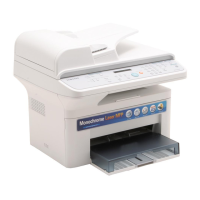
Do you have a question about the Samsung SCX4521F - B/W Laser - All-in-One and is the answer not in the manual?
| Print Technology | Laser |
|---|---|
| Print Output | Monochrome |
| Functions | Print, Copy, Scan, Fax |
| Print Speed | 20 ppm |
| Copy Speed | 20 cpm |
| Copy Resolution | 600 x 600 dpi |
| Scan Type | Flatbed |
| Fax Modem Speed | 33.6 Kbps |
| Paper Handling Output | 100 sheets |
| Connectivity | USB 2.0 |
| Paper Handling Input | 250 sheets |
| Media Type | Plain Paper, Envelopes, Labels, Card Stock |
| Media Size | A4, A5, Legal, Letter |
| Print Resolution | 600 x 600 dpi |
Guidelines for safe servicing, replacement parts, and laser safety.
Information on toxic materials and electric shock/fire safety precautions.
Instructions for safe handling, disassembly, and protection of sensitive parts like OPC drum.
Warnings regarding high-temperature parts, rotating parts, and safe lifting techniques.
Steps to prevent damage to electronic components from static electricity.
Safety advice for handling super capacitors and lithium batteries.
List of recommended tools for safe and easy troubleshooting.
Explanation of abbreviations and acronyms used throughout the service manual.
Guidelines for choosing an optimal environment for printer installation.
Description of standard test patterns used for factory measurements.
General overview of the SCX-4521F/4321 series, including target users and key features.
Detailed specifications including dimensions, weight, CPU, interfaces, power, and environmental conditions.
Technical details regarding printing method, speed, resolution, and memory.
Technical details for scanning functionality, including compatibility, method, speed, and resolution.
Details on copy speed, resolution, zoom range, and special copy features.
Specifications related to the fax and telephone functions, including dialing and sound controls.
Technical details for fax operations, including modem speed, compression, and resolution.
Information on input/output capacity, media sizes, types, and ADF capacity.
Details on software compatibility for operating systems, drivers, and applications.
List of included accessories and details on toner cartridge consumables.
High-level overview of the printer's main parts and their connections.
Detailed hardware specifications for the engine, including recording method and printing speed.
Description of the main board's function and the main controller's architecture.
Details on the CIS scanning method, image signal input, and processing.
Technical specifications of the fax modem chip, communication modes, and speeds.
Overview of the printing process, including PC interface and LSU control.
Functionality of the line interface for PSTN/PABX connection and TAD.
Specifications for paper feeding mechanisms, including cassette and manual tray.
Details on the developing method, toner type, and roller specifications.
Technical details of the fuser unit, including heat lamp, thermostat, and safety features.
Specifications for the CIS scanner, including size, resolution, and scan line time.
Description of the operational panel, key functions, and LCD display.
Details on the Power Supply Module (SMPS) and High Voltage Power Supply (HVPS).
Specifications for the HVPS board, including transfer and charge voltages.
Explanation of how AC power controls the fuser unit via a triac.
Essential precautions and procedures to follow before disassembling and reassembling the printer.
Step-by-step instructions for removing the Multi-Purpose (MP) tray.
Procedure for removing and exchanging the pick-up roller assembly.
Instructions on how to safely remove the front cover of the printer.
Procedure for opening and removing the paper cassette tray.
Steps for removing the rear cover, including jam cover access.
Instructions for removing the right side cover of the printer.
Procedure for removing the left side cover and speaker.
Steps for removing the scanner assembly, including connectors and cables.
Instructions for removing the ADF housing, including hinges and harnesses.
Procedure for removing the Operational Panel Equipment (OPE) unit.
Steps to remove the platen housing, including scan upper, battery, and belt.
Instructions for removing the middle cover and stacker.
Procedure for removing the High Voltage Power Supply (HVPS) unit.
Steps for removing the Main Printed Circuit Board Assembly (PBA).
Instructions for removing the RX drive, including gears and motor bracket.
Steps for removing the fuser unit, including connectors and internal components.
Procedure for removing the engine shield, LIU PBA, and SMPS.
Instructions for removing the Laser Scanning Unit (LSU).
Steps for removing the paper path frame, transfer roller, and solenoid.
Map of user settings available in User Mode, including paper, machine, fax, and sound settings.
Guide on entering Tech Mode for diagnostics and setting up the system.
Procedures for changing display language, machine ID, date/time, and clock mode.
Instructions for setting paper size/type and configuring speaker, ringer, key, and alarm sounds.
Methods for updating printer firmware locally and remotely.
Procedures for performing various machine tests like switch, modem, DRAM, ROM, pattern, and shading.
Details on accessing report lists for protocol, system data, key history, and error information.
Explanation of control panel buttons and their functions for copy, fax, scan, and save operations.
List of LCD status messages and their corresponding descriptions for error diagnosis.
Guide to Engine Test Mode for checking device conditions and diagnostics.
Diagrams and procedures for understanding paper paths and clearing jams.
Initial steps to diagnose printer problems by checking power, display, and print quality.
A checklist for initial inspection of power, LCD panel, paper path, print quality, and consumables.
Detailed checks for power, installation environment, paper type, and overall printer condition.
Troubleshooting for print position errors and paper jams (Jam 0, Jam 1, Jam 2).
Solutions for feeding multiple sheets at once and paper getting rolled in the fuser.
Troubleshooting for paper rolled in the toner cartridge (OPC drum).
Diagnosing and resolving issues related to LCD display defects and OPE keypad malfunctions.
Troubleshooting for paper empty errors, fuser gear jams, and cover open messages.
Resolving problems with defective motor operation, no power, and curved vertical print lines.
Troubleshooting printer not working due to software or environment setup.
Solutions for abnormal printing, driver errors, memory issues, and SPOOL errors.
Troubleshooting common Windows connectivity issues and SyncThru installation problems.
Diagnosing and resolving various bad image problems like lines, spots, density, ghosting, and stains.
Troubleshooting for no dial tone, defective MF dial, and fax forward/receive issues.
Resolving issues related to white copy, black copy, abnormal noise, and defective image quality.
Troubleshooting for PC scanning issues and poor quality of scanned images.
Information on toner cartridge service, precautions, and LCD error messages related to toner.
Exploded view of the main printer assembly with numbered parts.
Exploded view of the Automatic Document Feeder (ADF) assembly.
Exploded view of the platen cover assembly.
Exploded view of the ADF platen assembly components.
Exploded view of the Operational Panel Equipment (OPE) unit.
Exploded view of the pick-up unit components.
Exploded view of the main frame assembly parts.
Exploded view of the Multi-Purpose (MP) tray assembly.
Exploded view of the fuser unit and its components.
Exploded view of the paper path assembly components.
A system block diagram illustrating the interconnections of major printer components.
Diagram showing the electrical connections between various components and boards.
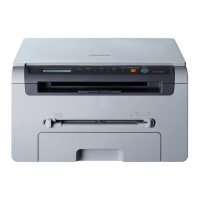



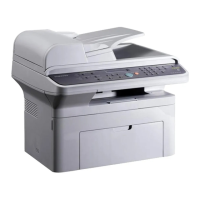

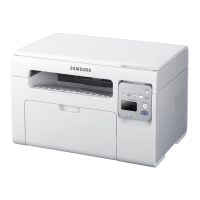
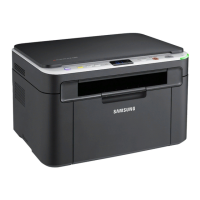
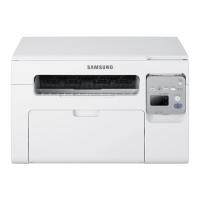


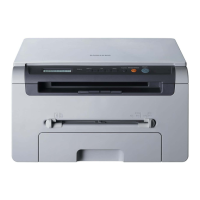
